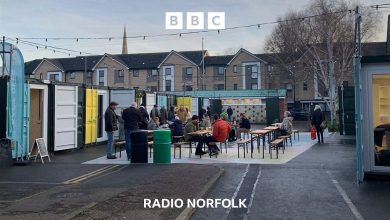UEA to launch contest to rethink Lasdun’s Ziggurats

The University of East Anglia (UEA) is embarking on an exciting new chapter in its history, as it seeks to breathe new life into two iconic Brutalist structures that have stood vacant for two years. The Norfolk and Suffolk Terraces, designed by the renowned architect Denys Lasdun, were once home to around 600 students, but were closed due to safety concerns over the use of reinforced aerated autoclaved concrete (RAAC). Now, the university is launching a design competition to find a team that can deliver a “viable future use” for these striking buildings, and is inviting interested parties to come forward and share their ideas. This is a unique opportunity for architects, designers, and engineers to put their stamp on a piece of history, and to help shape the future of this beloved campus.
The UEA has a long and proud history, dating back to its founding in 1963. The university’s campus, which occupies a stunning 130 hectares of parkland on the western fringes of Norwich, is home to around 17,000 students and features a range of iconic buildings that are steeped in architectural history. The Denys Lasdun-designed Norfolk and Suffolk Terraces are just two of the many notable structures on the campus, which also includes the famous Sainsbury Centre for Visual Arts, designed by Norman Foster and listed as a Grade II* building. The university’s early core buildings were listed in 2003, recognizing their importance as part of the UK’s architectural heritage. As the UEA looks to the future, it is clear that the preservation and reuse of these iconic buildings is a top priority, and that the university is committed to finding a solution that will do justice to their original vision and intent.
The design competition, which is set to launch in October, will provide a platform for innovative and creative thinking, as teams of architects, designers, and engineers come together to propose new and exciting uses for the Norfolk and Suffolk Terraces. The university has published a prior information notice, which invites interested parties to attend an onsite briefing and to provide feedback on the project. This is a unique opportunity for the university to engage with the design community, and to gather ideas and inspiration from a wide range of perspectives. By opening up the competition to a broad range of participants, the UEA is hoping to stimulate a lively and imaginative debate about the future of these iconic buildings, and to uncover new and innovative solutions that will breathe fresh life into the campus.
The Norfolk and Suffolk Terraces are just two of the many iconic buildings on the UEA campus, which has been shaped by some of the most influential architects of the 20th century. Denys Lasdun’s original vision for the campus was one of integrated, cohesive design, where buildings and landscapes would work together to create a sense of community and connection. The university’s Teaching Wall and Ziggurat accommodation blocks, also designed by Lasdun, are just a few examples of the many notable structures that can be found on the campus. Over the years, the UEA has continued to evolve and grow, with new buildings and facilities being added to the campus. However, the Norfolk and Suffolk Terraces remain two of the most iconic and enduring symbols of the university’s architectural heritage, and their reuse and preservation is a top priority for the UEA.
As the design competition gets underway, the UEA is keen to emphasize its commitment to finding a solution that will do justice to the original vision and intent of the Norfolk and Suffolk Terraces. The university is looking for a team that can deliver a “viable future use” for the buildings, one that will respect their history and significance while also bringing new life and energy to the campus. This is a challenging but exciting brief, and one that will require a deep understanding of the buildings’ architectural and cultural significance, as well as a willingness to think creatively and outside the box. By working together with the design community, the UEA is confident that it can find a solution that will preserve the integrity of these iconic buildings, while also ensuring that they remain relevant and useful for generations to come.
The UEA’s commitment to preserving and reusing its iconic buildings is just one part of its broader strategy for the future. The university has a long history of innovation and experimentation, and is constantly seeking new and better ways to support its students, staff, and the wider community. As the design competition for the Norfolk and Suffolk Terraces gets underway, the UEA is also looking to the future, and to the many exciting opportunities and challenges that lie ahead. With its stunning campus, rich architectural heritage, and commitment to innovation and excellence, the UEA is poised to remain one of the UK’s leading universities for generations to come. The reuse and preservation of the Norfolk and Suffolk Terraces is just one part of this story, but it is an important one, and a testament to the university’s enduring commitment to its values of creativity, community, and sustainability.








